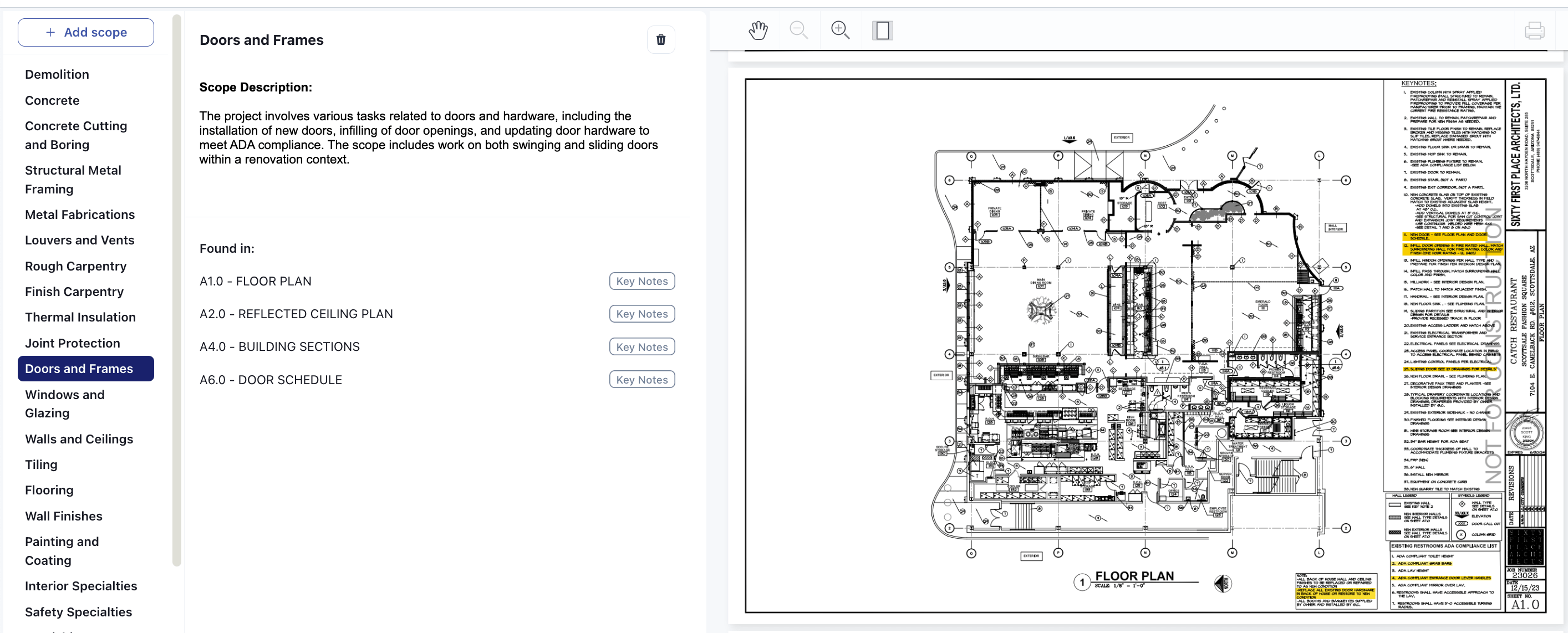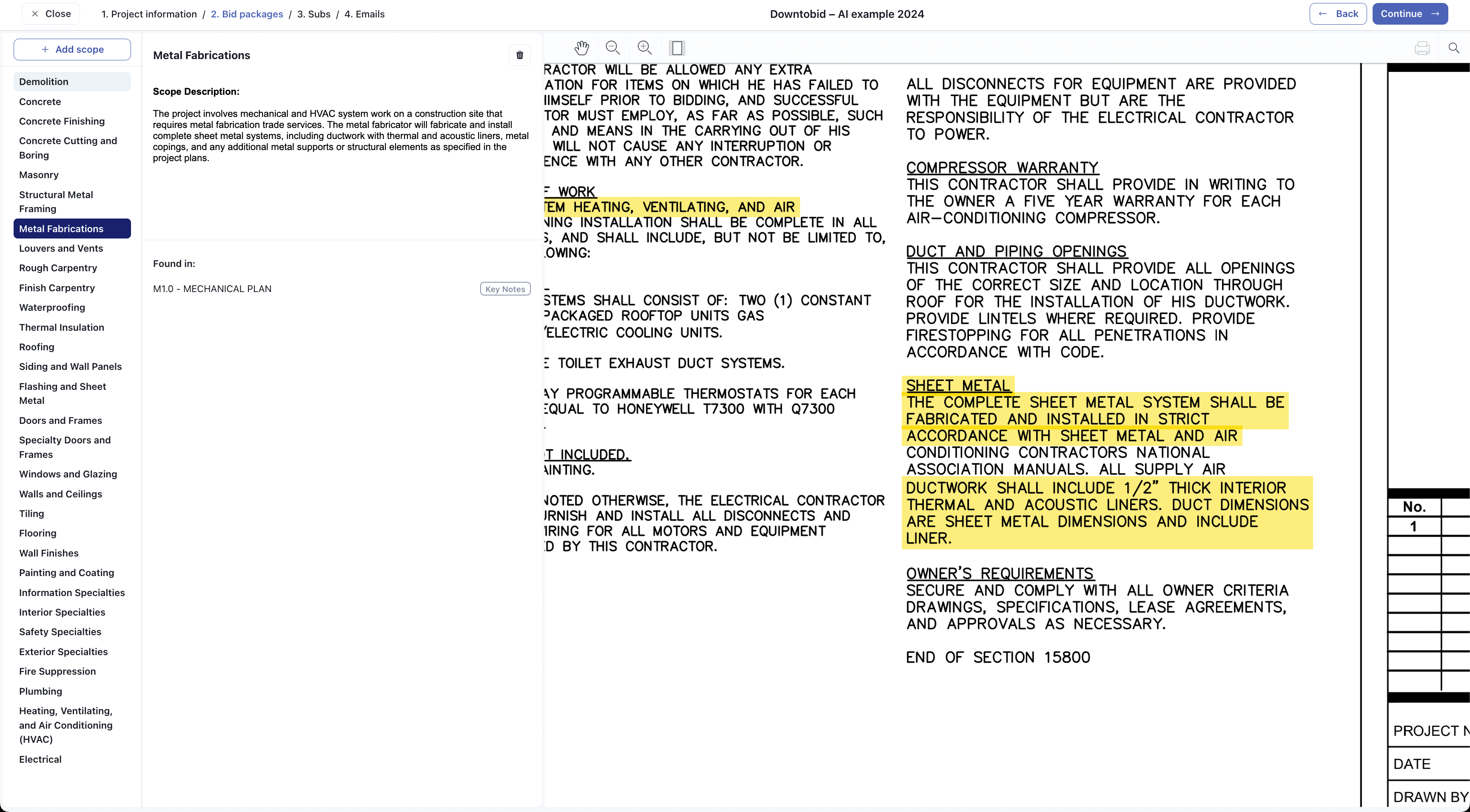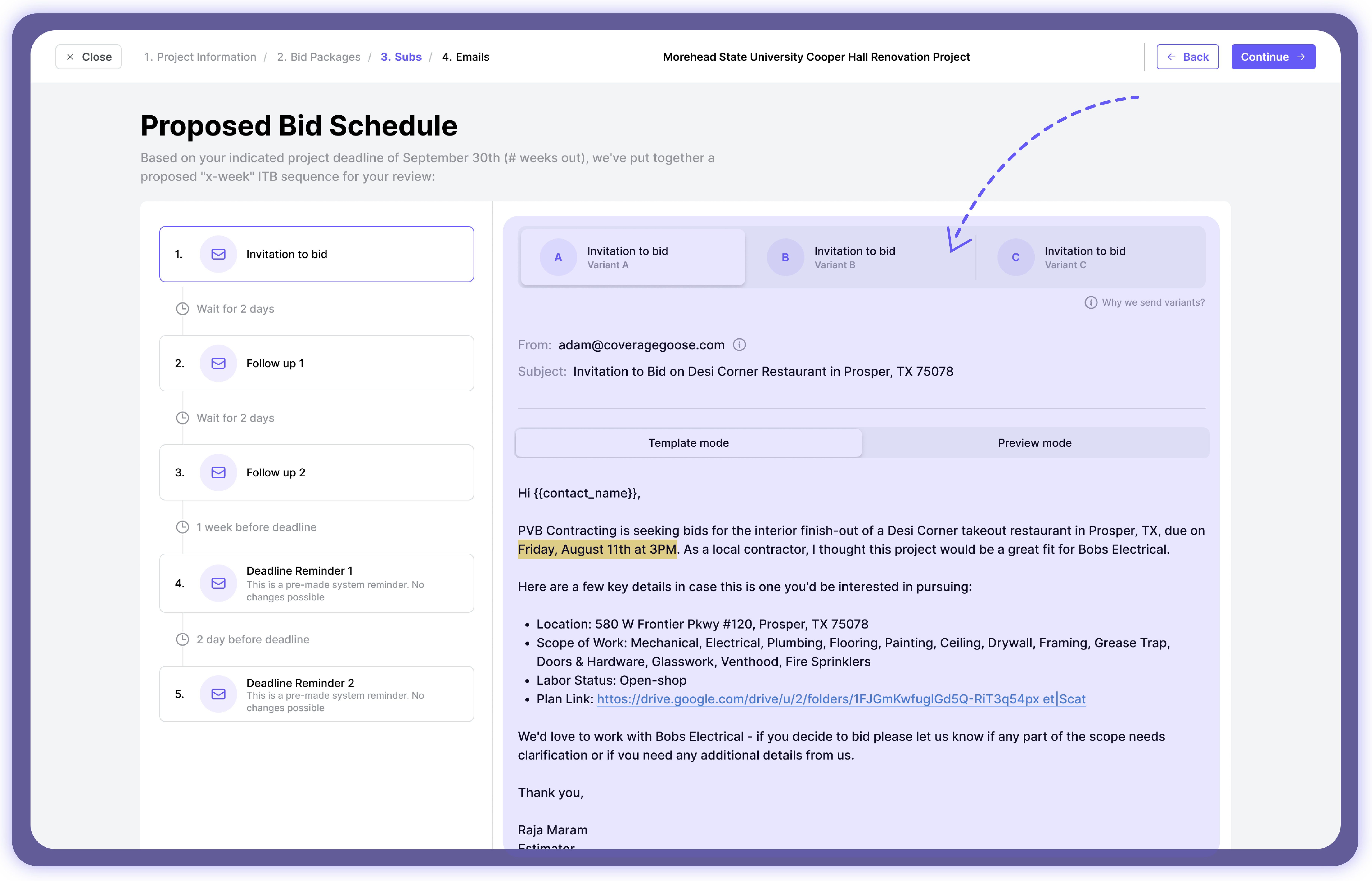You can't afford to cut corners when doing a construction takeoff. Whether you're bidding on a project, creating an estimate, or figuring out how much material to buy, nailing this step is crucial. Yet it eats up too much time.
And that's why we've put together this guide: to help you tackle takeoffs in a fraction of the time. In just a minute, we'll share a simple takeoff template that can make the process less of a headache. We'll also offer some tips for performing more accurate takeoffs, and introduce you to a platform that simplifies the estimation and preconstruction process.
Note: Need to quickly dissect project plans and send bid invitations to subcontractors (that actually get responses?) Check out Downtobid. Our AI tool breaks down construction drawings, curates a list of local, qualified subs for you, and sends personalized invitations to them. Try the platform for free today.
Key Takeaways
- Construction takeoffs determine exact material quantities and types needed for projects.
- Three steps: review documents, itemize materials, count/calculate quantities for accurate estimates.
- Supports bidding (competitive pricing), estimating (cost calculations), buying (procurement decisions).
- Free template includes material lists with quantities and unit costs.
- Downtobid's AI analyzes documents in minutes, identifies scopes, connects qualified subcontractors.
Download Our Free Construction Takeoff Template
At its core, a construction takeoff is just a list of the necessary materials for your project, with their quantities and unit costs. Sounds simple, but in reality, these takeoffs are really detailed documents. They specify every type of material, from measurements to pricing.
That said, we’ve aimed for a sweet spot with our takeoff template. It’s comprehensive enough to cover all your bases but simple enough to use without getting bogged down.

You can make a copy of it on Google Sheets here. You can also check out our other Excel templates on our blog here.
Construction Takeoffs in a Nutshell
Construction blueprint takeoff, also known as quantity takeoff or material takeoff, involves determining the exact quantities and types of materials you need for your project. This means counting everything from drywall and concrete to wood and prefabricated materials like windows, doors, and bathroom fixtures.
Usually, estimators, quantity surveyors, or project managers handle this job. They have the experience to know what’s needed and can spot where to save costs based on past construction projects. Their job is to nail down the quantities and costs to put together a competitive and profitable bid.
The Construction Takeoff Process
The takeoff process in construction typically follows a straightforward path with three main steps. They include:
Reviewing Construction Documents
This step involves diving into the blueprints and project specifications provided by the project owner, general contractor, or architect. These construction documents outline the scope of work and detail which materials are specified for the project — from basic components like drywall and lumber to specialized items like windows or HVAC systems.
The problem, though, is that this step can eat up too much of your time. Various construction documents can run up to 50, 100, or even 400 pages. Flipping through each one is not only tedious but also a breeding ground for errors and costly mistakes.
Under pressure, you might miss crucial info, causing delays and expensive change orders. This creates headaches not just for estimators, but for project managers who have to deal with the resulting schedule disruptions and budget overruns.
Also, this rush can affect potential subs, who might pad their bids or skip the entire bidding process altogether, driving up your project budget.
This is where AI tools for construction projects can save estimators' time and do most of the heavy lifting. Our platform uses AI to analyze construction documents, pinpointing required bid packages and linking them to the relevant pages. Downtobid makes reviewing and analyzing construction documents much faster and more accurate.

Consider this example: a Discount Tire project plan processed through Downtobid’s AI. If you’re curious, you can click this link to follow along.
In just about six minutes, the AI sifted through over 40 sheets of the plan—way faster than any team of estimators could. It managed to:
- Identify 31 potential scopes
- Provide summary outlines for each
- Highlight relevant details directly on the drawings

Sure, not every flagged scope will be spot on — there are always a few false positives. But the real win here is that AI gives you a solid starting point. You’re not starting from scratch and can focus on what truly matters for your construction project.
Itemizing Materials Required
Before you start doing the actual takeoff, it's smart to create a list of all the raw and prefabricated materials. This is important because some common materials need extra items and steps. Take concrete, for instance. It's not just a pile of cement. You’ll also need wire mesh to reinforce it, anchor bolts to secure steel to the ground, and maybe even waterproofing materials to protect it from moisture.
Take a moment to brainstorm before tallying up quantities. Walk through each phase of the project in your mind. What materials will you need at each stage? Are there any special requirements or additional items that go along with them?
Counting and Calculating Quantities
This part involves figuring out how much of each material you need to complete your construction project.
First off, counting. This involves tallying up individual items like wall studs, light fixtures, windows, and doors. Each piece counts—literally. Missing even one can throw off your entire plan, causing delays and additional costs
Then, there’s calculating quantities. Now, you're looking at measurements and dimensions. Think square footage for flooring and drywall, cubic yards for concrete, and linear feet for pipes or cables. If you underestimate, you might find yourself scrambling to order more materials midway through the construction project. Overestimate, and you risk unnecessary expenses cutting into your bottom line.
So measure twice, cut once -- as they say. Take into account any special configurations or adjustments needed for specific areas. For instance, if you’re estimating paint quantities, consider the surface area of each room and any additional coats required for a flawless finish.
What’s the Point of a Takeoff?
Takeoffs play a key part in three important processes in construction. They include:
Bidding Process
When you bid on a construction job, you need to estimate how much it will cost to complete. This includes a detailed report of all the materials your team needs, the quantities, and the associated costs — all part of the takeoff.
If your takeoff includes too many materials, your bid might be higher than your competitors', and you could lose out to someone with a lower price.
On the flip side, if your takeoff misses certain items, your bid might look appealingly low, but you’ll find yourself covering those hidden costs out of pocket. That can quickly turn a winning bid into a losing financial situation.
Beyond just financial considerations, a thorough takeoff also helps you identify potential risks before the project starts. For instance, if certain materials are hard to source or subject to price fluctuations, you can factor that into your bid.
Estimating Process
Some people might use "takeoff" to mean the whole estimating process, but it's clearer to see them as separate steps:
- Material/quantity takeoff: First, you get a precise list of all the quantities and materials needed.
- Construction cost estimate: Next, you take those quantities and include current prices for each material. You also factor in other costs like labor, equipment rental, and travel to get the whole project cost.
While these steps go hand-in-hand, the takeoff's main job is to nail down accurate quantities. The cost estimate then builds on that by figuring out what everything will cost. Start with the wrong quantities, and your estimate —and your project— could hit some bumps.
To get an accurate estimate, you first have to estimate how many hours your team will need to complete the job and what those hours will cost. Next, you need to consider all additional costs that come into play. Beyond labor, there are tools, equipment, permits, and unforeseen curveballs to account for. Whether it’s a delay in sourcing materials or sudden spikes in labor rates, having a buffer helps manage these surprises.
With all these variables in mind, you piece together the full estimate. You can read this blog post to master the art of creating accurate construction estimates or grab your free General Contractor Estimate template download.
Buying Process
Once you've nailed down your materials and estimated costs, it's time to figure out how much of everything you actually need to buy. Seems straightforward, but this step can shape the future of your project.
First off, accurate takeoffs guide your purchasing decisions. Knowing exactly what you need prevents last-minute runs to the store, which disrupt schedules and frustrate your project managers, general contractors, or owners. It also saves on time, fuel, and money, keeping everyone on the same page.
But beware of overbuying, too. Sure, it might seem like a good idea to stock up, but too much inventory cuts into your profits. Suddenly, those extra boxes of tiles or bundles of lumber are sitting there, costing you money instead of making it.
A detailed takeoff also makes ordering materials smoother. With a clear list of what you need, you can place accurate orders, avoid last-minute rushes, and possibly even get bulk discounts. Suppliers appreciate clear, accurate orders and might offer better service or pricing as a result.
Streamline the Preconstruction Process with Downtobid
Beyond helping you breeze through complex construction plans, Downtobid makes it easy to find the right commercial subcontractors for your job. You can send personalized invitations to your preferred subs from our tailored list or tap into our extensive network for more options.

Our platform crafts personalized bid invitations that actually include the subs' names and recognize their trade expertise right from the start. Each invitation includes clear scope summaries, so subs can quickly see if they’re a good fit for the new project without going through entire project plans.
Not only that, but our AI also suggests the best times to send out your ITBs. This way, you're reaching out at the right moment, meaning your invitations are less likely to get lost in the shuffle.

And we're just scratching the surface—there’s a lot more that Downtobid can do for you. Ready to streamline your preconstruction process? Start uploading your documents today and try out all the features of Downtobid.
Frequently Asked Questions
What is a take-off sheet in construction?
A construction take-off sheet (also called a quantity takeoff or material takeoff) is a detailed list of all materials needed for a project, including their quantities and unit costs. It specifies everything from drywall and concrete to windows, doors, and fixtures, serving as the foundation for accurate bidding, estimating, and purchasing decisions.
Can AI tools help with construction takeoffs?
Yes, AI tools like Downtobid can dramatically speed up the takeoff process. While traditional document review can take hours for 50-400 page plans, AI can analyze them in minutes. For example, Downtobid's AI processed a 40+ sheet project plan in just six minutes, identifying 31 potential scopes and highlighting relevant details—much faster than manual review.
What is an example of a construction takeoff?
A takeoff for concrete work would include: cubic yards of concrete needed, wire mesh for reinforcement, anchor bolts, and waterproofing materials. You'd calculate quantities based on square footage for flooring, linear feet for pipes, and count individual items like wall studs, light fixtures, windows, and doors.
What is takeoff software in construction?
Takeoff software is a digital tool that helps estimators determine material quantities and costs more efficiently. Modern platforms like Downtobid use AI to analyze construction documents, identify required bid packages, and streamline the preconstruction process—reducing manual review time and minimizing costly errors.
What's the difference between a takeoff and a cost estimate?
A takeoff provides a precise list of all material quantities needed. A cost estimate builds on that by adding current prices for each material, plus labor, equipment rental, permits, and other expenses to calculate total project cost. The takeoff focuses on quantities; the estimate translates those into dollars.